The year 2017 will be remembered by art lovers as the year of major international exhibitions. Almost simultaneously, three major events opened their doors to artists, curators and visitors in general: the Venice Biennale dArte (05.13.2017-26.11.2017), the Skulptur Projekte in Münster (06.10.2017-01.10.2017) and the five-yearly contemporary art event of Documenta (Athens 08.08.2017-16.07.2017 /Kassel (06.10.2017-17.09.2017).
Unlike VivaArte Viva, curated by Christine Macel, which places the state of the contemporary artist and the artistic experience itself at the center of the event, Documenta14 is a space for critical thought construction and contestation of the current world. For the first time since 1955, the year of the first edition, the artistic director of d14, Adam Szymczyk, chose to divide the exhibition into two different cities: Kassel and Athens. The decision in 2013, to title the 14th editionLearning from Athensand to place the German and Greek cities on the same level, took on a strong political connotation from the very beginning. In 2013, in fact, the Greek government was facing a major financial crisis to which Germany had responded very harshly, imposing severe measures and economic sacrifices on the Greek population in order to restore public debt. In this difficult political-economic context, Documenta wanted to stand as a critique and contestation of German economic imperialism toward what has always been Europe’s cultural cradle. The political and social crisis between Northern and Southern Europe was also a reflection of the global one on which the artists called to participate in this edition reflected: emigration, cultural censorship measures and financial crises were the main themes of these Documentas.
Until Sept. 17, 2017, it is still possible to visit documenta14 in Kassel, the German city in northern Asia that for more than 60 years has hosted one of the most important international exhibitions of contemporary art in terms of artistic and cultural debate. Over the course of the various editions, the city’s venues used for the exhibitions have expanded and, to date, include train stations, museums, galleries, art academies, university spaces, libraries, warehouses, squares, and parks.
Certainly the heart of the whole celebration remains lamplia Friedrichsplatz, built in the late 17th century, which, for this edition, hosts a mammoth installation by Argentine artist Martha Minujín, The Parthenon of Books - The Parthenon of Books (1983/2017).
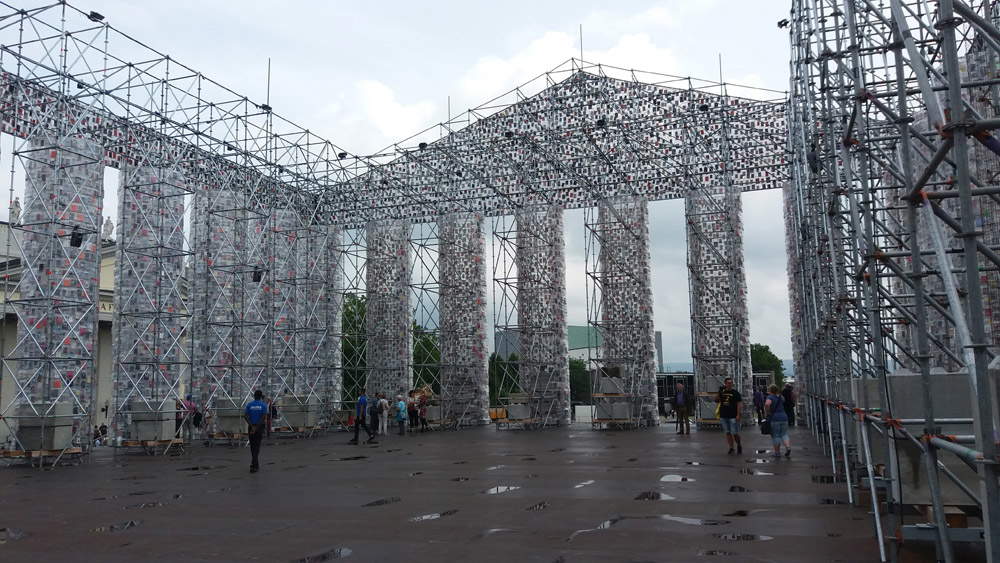 |
| Marta Minujín, The Parthenon of Books (1983-2017), documenta14 Kassel, Friedrichsplatz. Ph. Credit: Francesca Della Ventura |
The most important Greek temple, reconstructed today in Kassel, is a reminder not only visually, but also philosophically and culturally in general, to the other documenta venue, Athens. Listallazione had already been presented by the artist, in 1983, in the plaza of Buenos Aires: the Parthenon’s columns, as well as its other load-bearing architectural structures, were made up of 25,000 books banned by the Argentine militia. Minujín wanted to replicate this installation for documenta14 as well: the temple, a symbol of democratic political ideals, restores their memory in the face of dictatorships that challenge them. For this event, the artist invited d14 visitors to donate books that are all-today banned in the rest of the world and, with them, build the temple.
Friedrichsplatz houses the historic building called the Fridericianum, the birthplace of documenta. In connection with Athens and the adjacent Parthenon, its interior displays, for the first time beyond Greek borders, the collection of theEMST, the Greek capital’s national museum of contemporary art. The title of the exhibition is ANTIDORON, which literally means the return of a gift (or loan), a reference not only to the return of a financial loan, but also and especially to a cultural and linguistic one. From the 180 works by the 82 artists located on the four levels of the building hardly emerge clearly the existential, cultural and collective memory themes that are in the main project ofEMST curator and director Katerina Koskina. While one is fortunate to be able to take advantage of an darte collection that for the first time is exhibited outside the national borders, there is to be affirmed doubt in the choice (and their decontextualization in an unclear exhibition itinerary) of the 180 pieces from a collection originally of nearly 2,000 works.
In contrast, the Neue Galerie at the Schöne Aussicht, is definitely the best exhibition of this edition of the Kassel documenta14. The building, built in 1877 to celebrate the German triumph in the Franco-Prussian War, is home to the dAssia and Kassel darte collection from the 19th to 21st centuries. On the occasion of documenta14, all available exhibition spaces were used, revolutionizing the overall museum itinerary for a few months. The resulting operation is commendable and well successful as a whole: questions of national identity and belonging, as well as those pertaining to cultural policies, are at the center of the dialogue among the artists represented and develop to encompass broader and more complex themes, such as those of European colonialism and artistic experience under conditions of war and dictatorial control and censorship.
On the ground floor, the exhibition itinerary accommodates, at the center of reflection, contestations to all forms of repression, whether political, sexual, cultural, social and of physical disability, placing as its core the freedom of being of each individual. The itinerary features the installations of Antonio Vidal, Cuban painter and sculptor, who died in 2013, and is best known for his determined and tenacious opposition against all forms of dictatorship; the video installations and photographs of the duo Annie Sprinkle and Beth Stephens, since the late 1980s engaged in feminist issues, queer culture and eroticism, as well as the representation of the pornographic, especially with regard to the rights of women employed in it. With Lorenza Böttner’s extraordinary works, we move on to reflect on the category of physical disability and that pertaining to the sphere of one’s sexuality. Despite lamputation of her arms, Ernst Lorenz Böttner, later to become Lorenza, was a dancer and artist who painted with the use of her mouth and feet, transforming her life into a continuous performative action darte. Joseph Beuys’ restored installationDas Rudel(1969), exhibited since 1976 on only three occasions (New York, London, and Düsseldorf), dominates the central space of the ground floor: on the one hand it is meant to be a tribute to Beuys himself, who was the undisputed protagonist of several documenta editions; on the other hand, it is a work representative of how the artist himself considered chaos and dynamism essential for change in contemporary society.
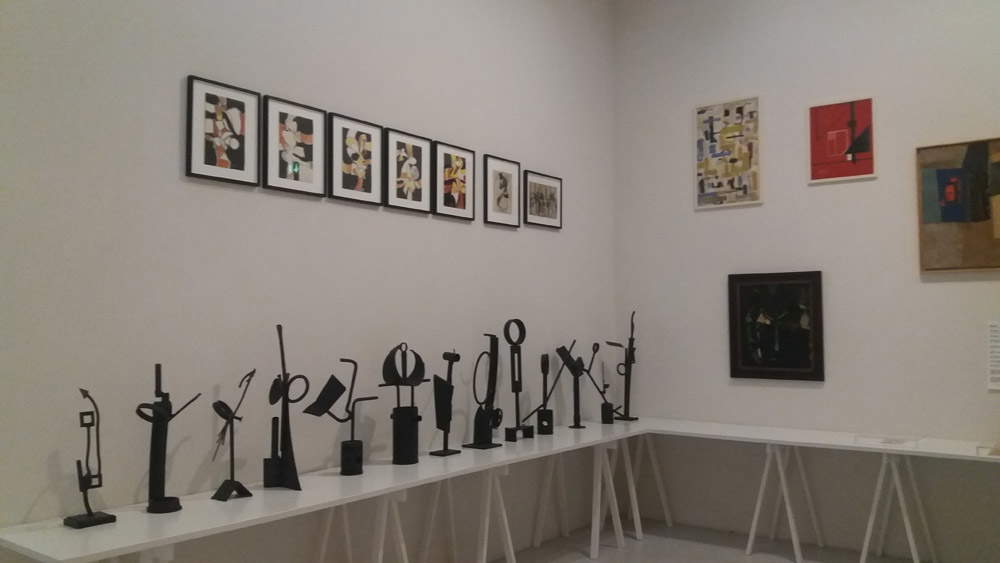 |
| Antonio Vidal, Multiple sculptures, paintings, and works on paper (2017), documenta14 Kassel, Neue Galerie. Ph Credit: Francesca Della Ventura |
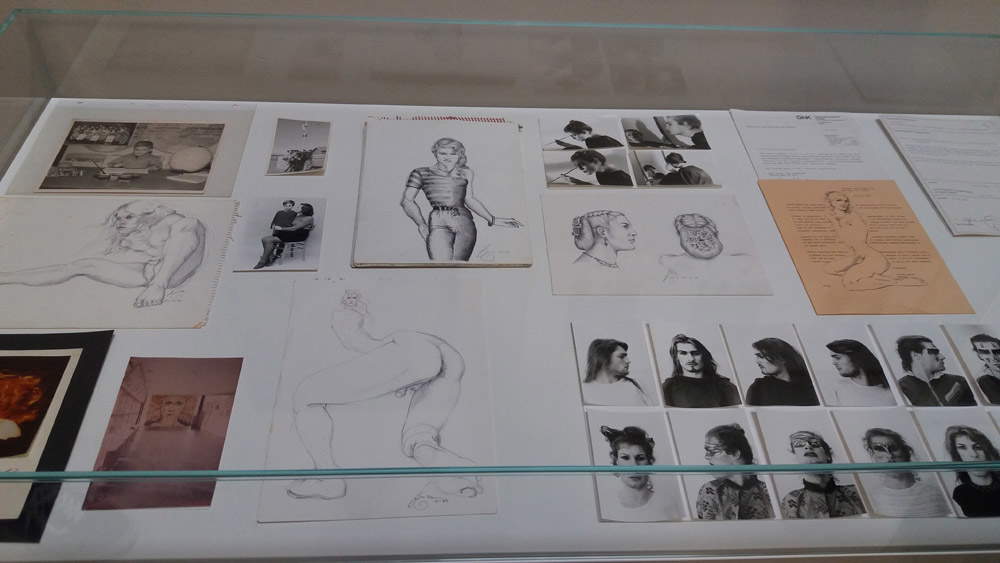 |
| Lorenza Böttner, Drawings on paper, photographs, archival materials (1975-94) documenta14 Kassel, Neue Galerie. Ph. Credit: Francesca Della Ventura |
 |
| Lorenza Böttner, Self-portrait, documenta14 Kassel, Neue Galerie. Ph. Credit: Francesca Della Ventura |
 |
| Joseph Beuys, Das Radel (1969), documenta14 Kassel, Neue Galerie. Ph. Credit: Francesca Della Ventura |
On the second floor, however, the leading theme is that of European colonialism and cultural imperialism. From Maria Eichhorn’s installation,Unrechtmä�?ig aus jüdischem Eigentum erworbene Bücher(2017), we connect back to the Greek collection on display at the Fridericianum and, thus, to the underlying theme of these documenta14- with a series of modern-age paintings and views by Greek and German artists having the Parthenon as their subject. Next, contrasting the neoclassical marble sculptures are the Länderfiguren on the ground floor, those representing Buddhist or African idols. Photographs and paintings depicting the abuses of late 19th-century European colonialism fill the final exhibition spaces, reaching the climax of the narrative in installations by Senegalese artist Pélagie Gbaguidi. Through drawings of African children, Gbaguidi delivers her message ofhope-We are all people-whichis also featured, in multiple foreign languages, on the banners of the building overlooking Friedrichsplatz.
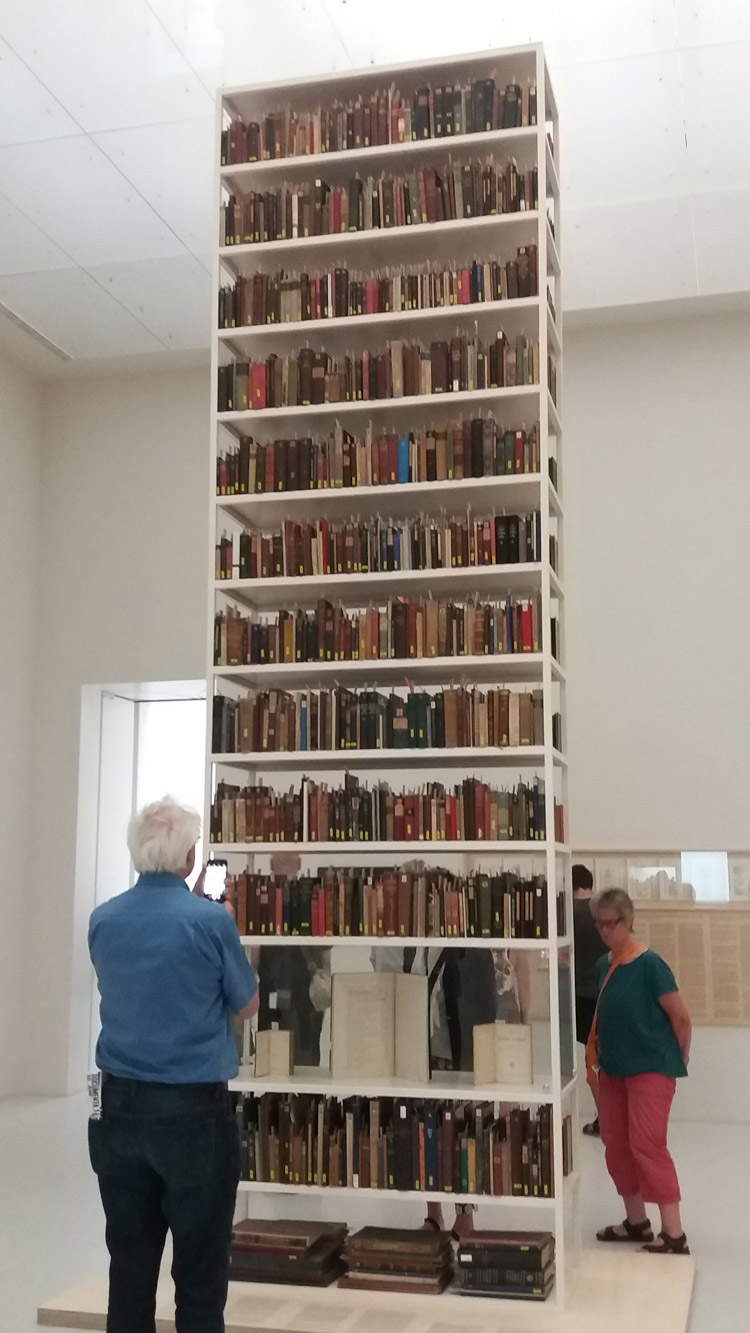 |
| Maria Eichhorn, Unrechtmä�?ig aus jüdischem Eigentum erworbene Bücher (Bonn 2017), documenta14 Kassel. Ph Credit: Francesca Della Ventura |
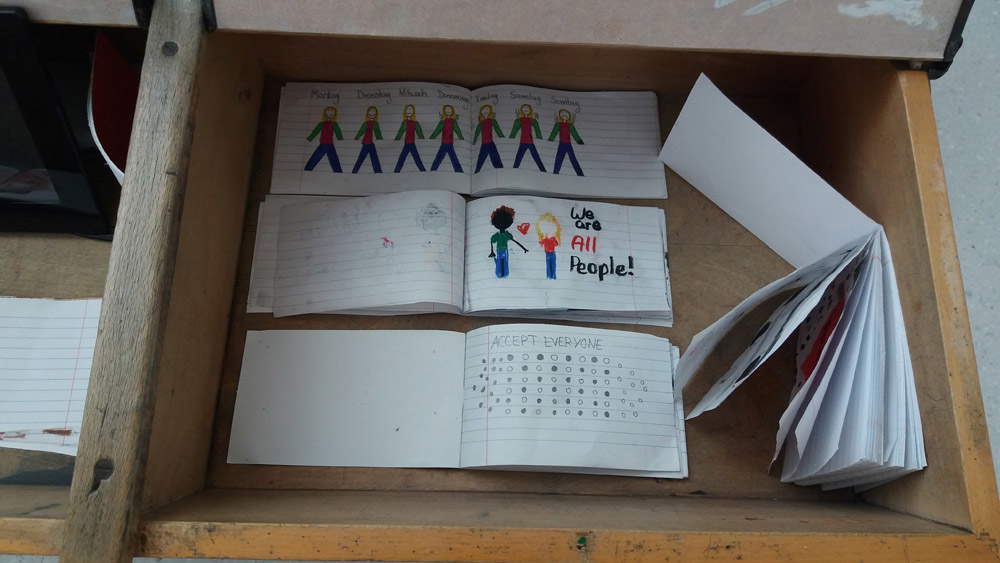 |
| Pélagie Gbaguidi, The Missing Link. Dicolonization Education by Mrs Smiling Stone (2017), documenta14 Kassel, Neue Galerie. Ph. Credit: Francesca Della Ventura |
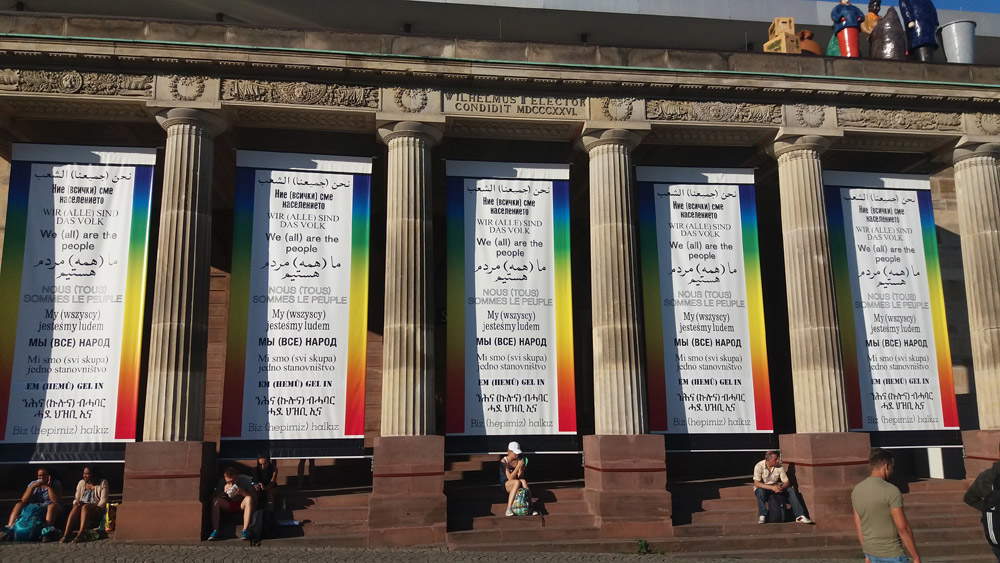 |
| We are (all) the people, Friedrichsplatz, documenta14 Kassel, Neue Galerie. Ph. Credit: Francesca Della Ventura |
In the gigantic and relaxing park calledKarlsaue, not far from the Fridericianum and Documenta Halle, one can observe a series of projects and installations, such as the one created by the collective Ciudad Abierta. The community, founded in 1965, is simultaneously a pedagogical experiment and an architectural laboratory, formed by poets and artists, with the aim of creating a utopian community within an ideal city in which life, work and study are its pillars. In 1965 Ciudad Abierta carried out the first traveling crossing of South America for the dissemination of their thought. For documenta14, the exhibition project at theKarlsauePark,Amereida Phalene Latin South América, involved Chilean, Italian and German universities with the goal of giving visitors a place where they can meet different cultures and dialogue openly.
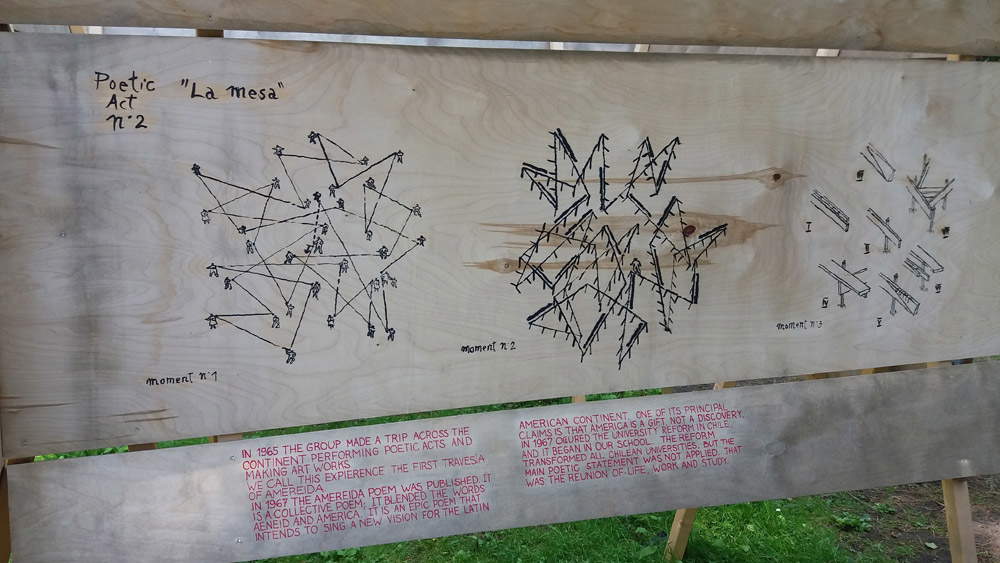 |
| Ciudad Abierta, Amereida Phalene Latin South América (2017), Karlsaue, documenta14 Kassel, Neue Galerie. Ph. Credit: Francesca Della Ventura |
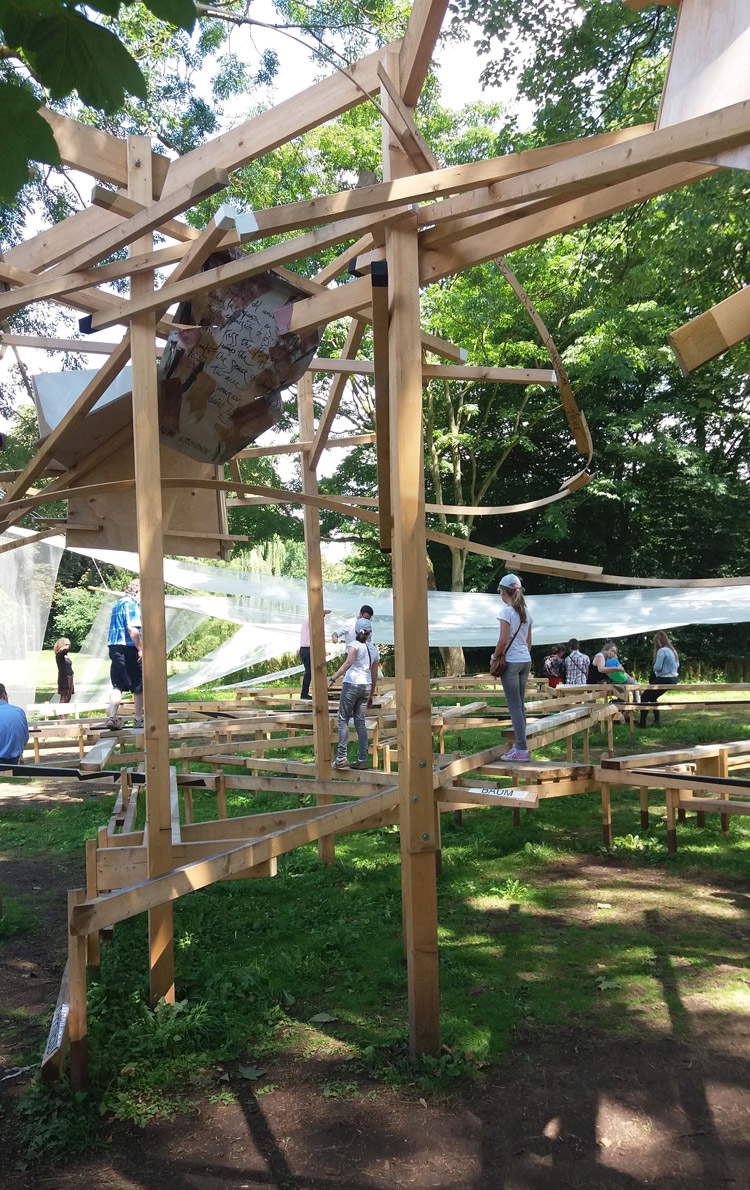 |
| Ciudad Abierta, Amereida Phalene Latin South América (2017), Karlsaue, documenta14 Kassel, Neue Galerie. Ph. Credit: Francesca Della Ventura |
Heading northeast of the city of Kassel, one encounters the Neue Galerie (Neue Hauptpost), a newly constructed building opened in 1975 as the headquarters of the central posts and postal distribution center. The choice made on this particular location is not accidental: for those who have visited the entire documenta14 itinerary it appears as the natural landing point at the end of this journey into the world of contemporary art.
The search for and definition of one’s own identity is at the center of the work of Norwegian artist Máret Ánne Sara, while the theme of democratic revolution within cultures marked by regimes of dictatorial oppression guides the work of artists, such as, for example, that of Arin Rungjang, with his monument to democracy,246247596248914102516 And then there were none, made in cooperation with Bangkok and the University of Athens.
At this point, the choice to place here the documentary made byThe Society of Friends of Halitseems extremely interesting and significant. The video documentary chronicles the racially motivated terrorist acts that occurred in Kassel in 2011 at the hands of right-wing extremists from the NSU (Nationalsozialistichen Untergrunds). The ambushes led to the deaths of about a dozen very young boys of Turkish origin and were recognized by German institutions as terrorist attacks only after a popular demonstration involving more than 4,000 people in the city of Kassel.
In the gigantic video-installationAtlas fractured(2007) by the London-based artist, Theo Eshetu, thousands of human faces belonging to the world of history and the contemporary-are fragmented and rejoined together in a visual escalation that leads the viewer to the mental reconstruction of a single face and a single race, the human race.
 |
| Theo Eshetu, Atlas Fractured (2017), documenta14 Kassel, Neue Neue Galerie. Ph. Credit: Francesca Della Ventura |
As the final legacy of these documenta14, we can embrace the same message as the London-based artist: there are no races, there is no diversity in the global world, but only one Atlas, and it is to the peaceful maintenance of this that human beings are all called to participate, respecting the cultural and ontological freedom of each individual.
Warning: the translation into English of the original Italian article was created using automatic tools. We undertake to review all articles, but we do not guarantee the total absence of inaccuracies in the translation due to the program. You can find the original by clicking on the ITA button. If you find any mistake,please contact us.